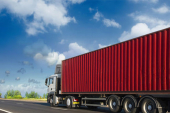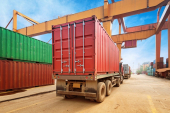Export containers, often referred to as shipping containers, are large, standardized containers used for transporting goods internationally via sea, rail, or truck. These containers are designed to facilitate the efficient, secure, and cost-effective movement of cargo across long distances. Here are the key aspects of export containers:
Types of Export Containers
1. Dry Containers:
- Standard Containers: Typically 20-foot or 40-foot in length, these are the most common containers used for general cargo.
- High Cube Containers: Similar to standard containers but taller, offering more volume for cargo.
2. Refrigerated Containers (Reefers):
- Used for transporting perishable goods that require temperature control, such as food, pharmaceuticals, and flowers.
3. Open Top Containers:
- Feature a removable roof, suitable for over-height cargo that cannot be easily loaded through standard container doors.
4. Flat Rack Containers:
- Have collapsible sides, ideal for oversized or heavy machinery and equipment that needs to be loaded from the top or sides.
5. Tank Containers:
- Used for transporting liquids, gases, and chemicals. These containers have a stainless-steel tank mounted inside a standard frame.
6. Ventilated Containers:
- Designed for cargo that needs airflow during transport, such as coffee beans and certain agricultural products.
Key Features
- Standardized Sizes: Most export containers come in 20-foot (TEU) and 40-foot (FEU) lengths, allowing them to be easily transferred between different modes of transport.
- Durability: Made from materials like steel or aluminum, containers are built to withstand harsh environmental conditions and rough handling.
- Security: Equipped with secure locking mechanisms to protect cargo from theft and tampering.
- Stackability: Designed to be stacked during transport and storage, optimizing space on ships and in ports.
Uses and Benefits
- Efficient Transport: Containers allow for easy loading, unloading, and transfer between ships, trucks, and trains, streamlining the logistics process.
- Cost-Effective: By standardizing cargo sizes and handling methods, containers reduce shipping costs and improve economies of scale.
- Cargo Protection: Containers provide protection against weather, damage, and theft, ensuring goods arrive in good condition.
- Flexibility: Suitable for a wide range of goods, from bulk commodities to specialized cargo requiring specific conditions.
Logistics and Handling
- Intermodal Transport: Containers are designed for intermodal transport, meaning they can be seamlessly transferred between different modes of transport without unloading the cargo.
- Container Shipping Lines: Companies that operate fleets of container ships and offer shipping services to move containers globally.
- Ports and Terminals: Specialized facilities equipped to handle large volumes of containers, including cranes and storage areas.
Regulations and Standards
- ISO Standards: Containers are built to International Organization for Standardization (ISO) specifications to ensure compatibility worldwide.
- Customs and Documentation: Export containers must comply with customs regulations and require proper documentation, such as bills of lading and export licenses.
Export containers play a crucial role in global trade, enabling the efficient and secure transport of goods across international borders. Their standardization, durability, and versatility make them indispensable in the logistics and supply chain industry.

Loading containers efficiently and safely involves a combination of planning, organization, and proper handling techniques. Here are some key tips to consider:
1. Plan Ahead:
- Understand the Cargo: Know the weight, dimensions, and fragility of items to determine the best way to load them.
- Create a Loading Plan: Sketch out the layout of the container and decide on the placement of each item to maximize space and ensure stability.
2. Distribute Weight Evenly:
- Balance the Load: Place heavier items on the bottom and distribute weight evenly from front to back and side to side to prevent shifting during transit.
- Center of Gravity: Keep the center of gravity low and centered to maintain container stability.
3. Use Proper Packing Materials:
- Pallets and Crates: Use pallets and crates to organize smaller items and facilitate easier handling.
- Dunnage: Use dunnage materials such as airbags, cardboard, or foam to fill gaps and prevent movement.
4. Secure the Load:
- Straps and Ties: Use straps, ropes, and cargo nets to secure items in place.
- Blocking and Bracing: Employ blocking and bracing techniques to immobilize heavy items.
5. Follow Weight Limits:
- Container Capacity: Do not exceed the container’s maximum payload capacity.
- Axle Weight Regulations: Ensure that the load complies with local and international axle weight regulations.
6. Utilize the Container Space Efficiently:
- Stacking: Stack items to utilize vertical space, ensuring that heavier items are on the bottom.
- Floor Space: Use the floor space effectively, avoiding empty gaps that can lead to load shifting.
7. Consider Special Requirements:
- Temperature Control: For perishable goods, use refrigerated containers and monitor temperature.
- Hazardous Materials: Follow specific regulations and guidelines for loading hazardous materials.
8. Label and Document:
- Mark Items: Clearly label all items with their contents and handling instructions.
- Document the Load: Maintain a detailed inventory list and loading diagram.
9. Safety Precautions:
- Personal Protective Equipment (PPE): Ensure that all personnel involved in loading wear appropriate PPE.
- Training: Provide proper training to staff on safe loading and handling practices.
10. Inspect the Container:
- Check for Damage: Inspect the container for any damage or weaknesses before loading.
- Cleanliness: Ensure the container is clean and free from debris that could damage the cargo.
By following these tips, you can enhance the efficiency and safety of your container loading process, ensuring that goods arrive at their destination in optimal condition.

Ensuring the safety of containers during export is crucial to prevent damage, loss, and accidents.
comprehensive safety tips for exporting containers
1. Inspect the Container:
- Structural Integrity: Check for any physical damage, rust, or wear and tear. Ensure the container doors are functioning properly and seals are intact.
- Cleanliness: The container should be clean and dry to prevent contamination or damage to the cargo.
2. Load Securely:
- Weight Distribution: Distribute weight evenly to avoid shifting during transit. Place heavier items at the bottom.
- Blocking and Bracing: Use wood blocks, metal bracing, and other materials to prevent movement.
- Straps and Ties: Secure cargo with straps, ropes, or cargo nets to keep items in place.
3. Follow Weight and Capacity Limits:
- Max Payload: Do not exceed the container’s maximum payload capacity.
- Weight Regulations: Ensure compliance with local and international weight regulations to avoid fines and ensure safe handling.
4. Use Proper Packaging:
- Protective Materials: Use bubble wrap, foam, pallets, and crates to protect items from damage.
- Dunnage: Fill empty spaces with dunnage to prevent movement and absorb shocks.